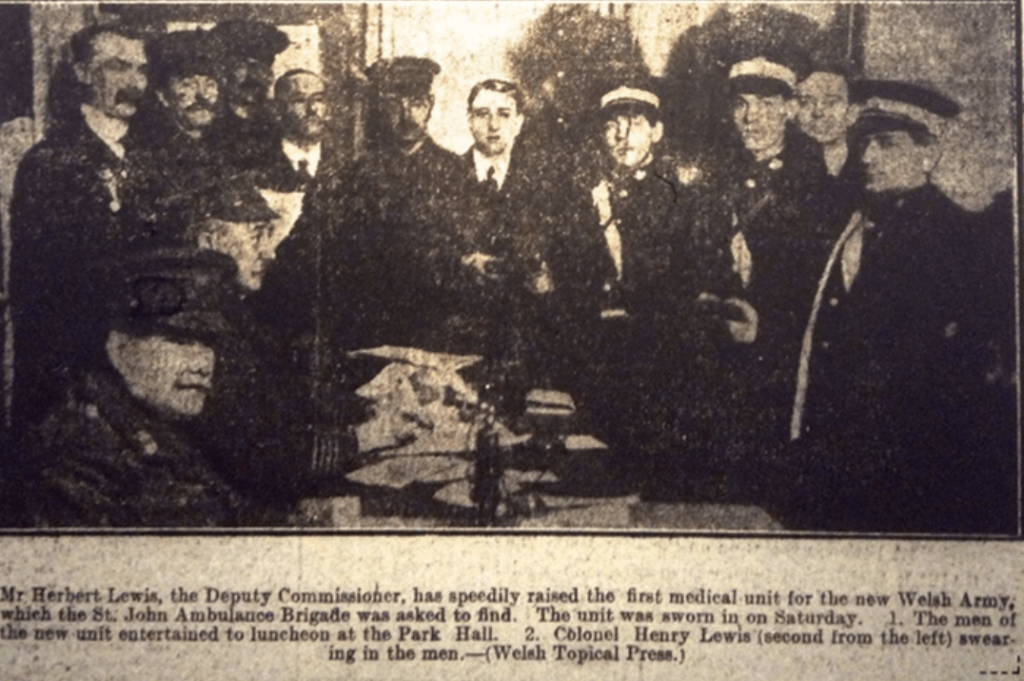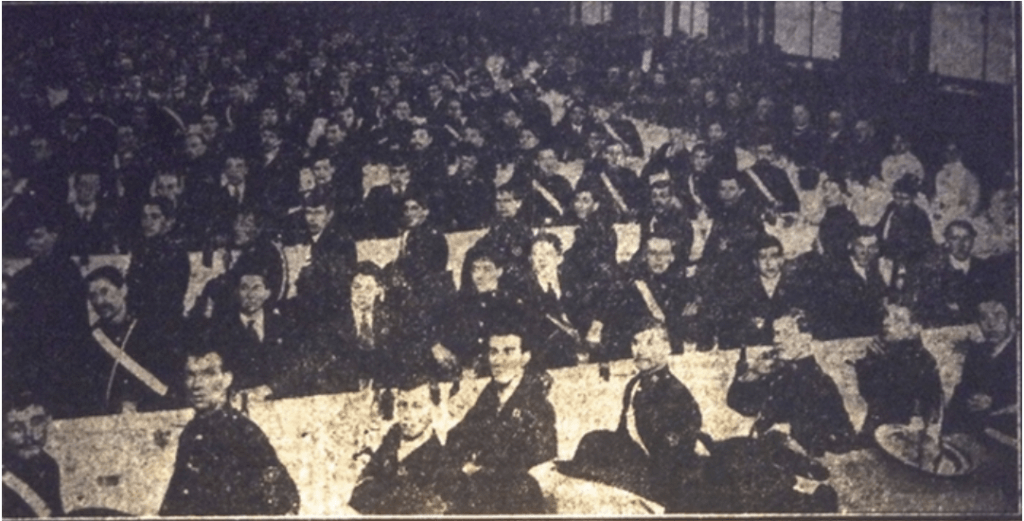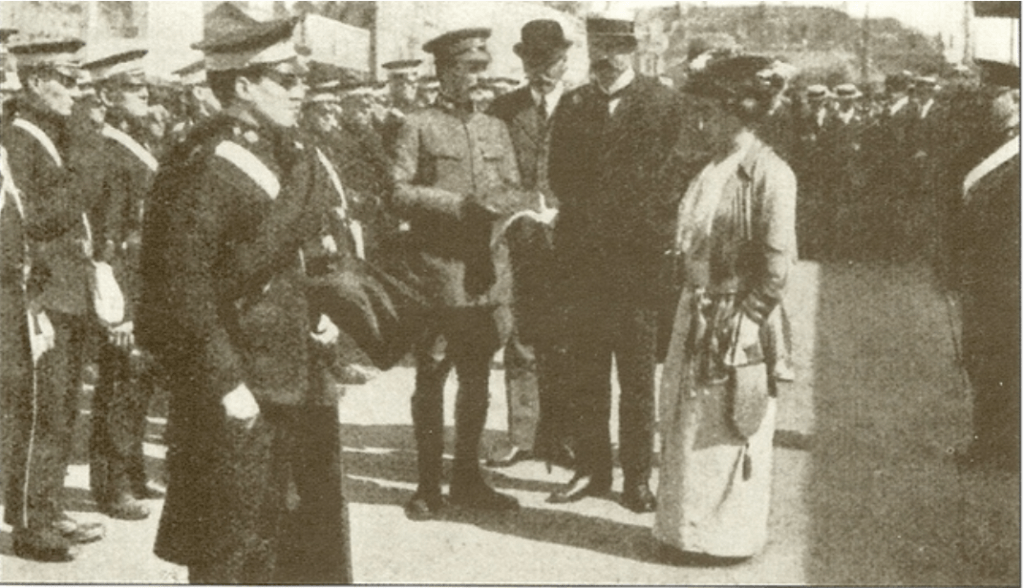The content for this section of the Unit’s history has been lost during the malicious hacking attack of the original website and I will be attempting to revive this data over the next few days.
On the 12th December 1914 the Field Ambulance Unit raised by Mr Herbert Lewis (Deputy Commissioner of Number XI district, St John Ambulance Association, South Wales) was mobilised and handed over to the Welsh Army Corps at the St David’s Centre in Cardiff.

St John men being attested at the St David Centre, Cardiff on Saturday 12th December 1914
The image above is reproduced here by kind permission of Media Wales Ltd and the Newport Community Learning and Libraries, South Wales.
After being attested, they were given a day’s pay of 1s 2d ( 6p in today’s money with an equivalent value of about £6.80) and a day’s ration allowance of 1s 9d (9p in today’s money) and then the men were entertained to dinner by the Lord Mayor at Park Hall, Cardiff and were inspected and addressed by Lord Plymouth. He said “I am glad to inspect the men of the St David’s Centre who are here to form a Field Ambulance of the Welsh Army Corps. As Ambulance Director, I am proud of the way in which the men have come forward and feel it an honour to inspect such a fine body of men and the General can feel proud of them.” The men were dismissed at 4pm on the 12th and returned to their billets.

The men of the new Field Ambulance Unit being entertained to luncheon at the Park Hall, Cardiff on Saturday 12th December 1914
The image above is reproduced here by kind permission of Media Wales Ltd and the Newport Community Learning and Libraries, South Wales.
On Sunday 13th, the men of the new Unit paraded at the drill hall in Newport Road (which was to be the Unit Headquarters while they where based in Cardiff) and then marched to St John’s Church for Sunday service. 48135 Sgt Clifford W Jarman records ‘A very amusing incident occured after the sermon. The Clergyman said he wished to say a few words to the St John Ambulance Brigade who were only mobilized yesterday. He wished us Gods speed as we were to proceed to the Front tomorrow! This came as a great shock to all present, who though hoping to go out soon did not expect it quite so suddenly.’ Needless to say, the men heard nothing more about this and were dismissed after church for the rest of the day.
The following day, the men paraded at the Drill Hall at 9am and were taken on a route march. After lunch, men who wished to apply to be Drill Sergeants, cooks, clerks motor drivers, dispensers etc were told to line up for interview for these posts. These interviews took several days. 48064 S/Sgt Lawrence Williams was appointed Senior Staff Sergeant the following day and interestingly, his is the 1st (lowest) regimental number issued to men of the Unit. Over the next few days the men were put through various drills and went on several route marches. On Thursday 17th they were instructed in Swedish Drill (a system of gymnastics invented at the turn of the 19th century by Pehr Henrih, a fencing instructor in southern Sweden to promote exercise as a means to improved public health) by Sgt Evan Thomas Owen (who ultimately did not go out to France with the Unit as he was subsequently commissioned).
On Friday 18th the Unit was inspected by the Earl of Plymouth (Chairman of the executive committee of the St John Ambulance Brigade) and General Mackinnon GOC in C Western Command. Much time was spent filling in forms on the following day and 48128 Francis B Sumption was appointed chief Sgt Dispenser. On Sunday there was again a church service and on Monday 21st, following more Swedish Drill, the Unit was divided into three sections, A, B and C. Capt Anderson took the parade the following day and when he asked for men who wished for leave over Christmas to take one step forward, the entire Unit moved! On Wednesday 23, following parade at 9.30 the men were issued with railway warrants and passes and sent home on leave until the 29th December, those living furtherest away being dismissed first.
The Glamorgan Gazette issue published on the 1st January 1915 (http://welshnewspapers.llgc.org.uk) reported that on Christmas Eve in Ogmore Vale, a nine year old girl ran out into the street with her clothes on fire and 48177 Pte Albert W Reed with great promptitude immediatley wrapped a coat around her and extinguished the flames while both 48068 Sgt Frank J King and 48564 Pte Edward Pinkard also rendered assistance. Possibly the first casualty treated by the men as members of the Unit.

Herbert Lewis inspecting the men
Lt Col Davies arrived in Cardiff on the 28th December as many of the men were returning from their Christmas leave. The Unit paraded at 11.30 at the Drill Hall and marched to Cathays Park, where they had their photographs taken (we have yet to come across any of these photographs) and after lunch the Unit left the Drill Hall and marched to the station with great gusto, headed by the band of the 3rd Welsh Regiment. The Unit then lined up outside the station where Mr Herbert Lewis formally handed over command of the Unit to Col Davies, much to the men’s relief as recorded by 48135 Clifford W Jarman. Once the men had boarded the train, the Lady Mayoress of Cardiff (Mrs J Richards addressed a few words to the Unit and the train steamed out of the station to the sound of the band playing ‘Auld Lang Syne’.

Be the first to comment